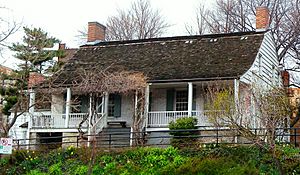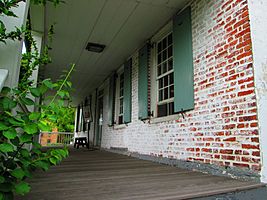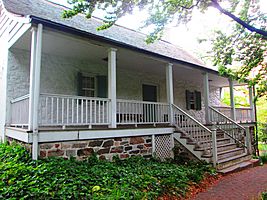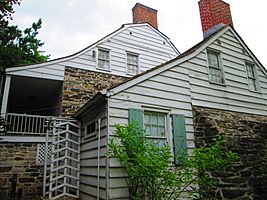Dyckman House facts for kids
|
Dyckman House
|
|

(2011)
|
|
| Location | 4881 Broadway, Inwood, Manhattan, New York City |
|---|---|
| Nearest city | New York City |
| Built | c.1785 |
| Architectural style | Dutch Colonial |
| NRHP reference No. | 67000014 |
Quick facts for kids Significant dates |
|
| Added to NRHP | December 24, 1967 |
| Designated NHL | December 24, 1967 |
The Dyckman House, also known as the Dyckman Farmhouse Museum, is the oldest farmhouse still standing on Manhattan island. It shows us what New York City was like when it was mostly farmland. This farmhouse was built in the Dutch Colonial style around 1785. It was built by William Dyckman and was part of a huge farm, over 250 acres (100 hectares) big. Today, you can find it in a small park in Inwood, Manhattan, at the corner of Broadway and 204th Street.
Contents
The Dyckman Family and Their Home
Who Was William Dyckman?
William Dyckman was the grandson of Jan Dyckman. Jan came to this area from a place called Westphalia in 1661. William inherited the family's land. He built the current Dyckman House to replace an older family home. That first house was built in 1748 near the Harlem River. Sadly, it was destroyed during the American Revolutionary War.
What Does the House Look Like?
The Dyckman House has two stories. It is made from fieldstone, brick, and white clapboard (wooden boards). It has a special roof called a gambrel roof, which has two different slopes on each side. The porches on the house were added in 1825 and are typical of the Dutch Colonial style.
Inside the house, you'll find parlors (living rooms). There's also a winter kitchen in the basement. This basement kitchen helped keep the first floor warm. The floors inside are made of chestnut wood, with boards of different widths. Outside, there's a small building to the south that was used as a smokehouse and summer kitchen. This building might even be older than the main house! Behind the house, there's a short hedge that looks a bit like a maze.
How the House Became a Museum
The Dyckman family owned the house for many generations. But in 1868, they sold it. For several decades, it was rented out to different people. By the early 1900s, the house was in bad shape and almost torn down. Luckily, in 1915, the Dyckman family bought it back.
Two sisters from the Dyckman family, Mary Alice Dyckman Dean and Fannie Fredericka Dyckman Welch, decided to fix up the farmhouse. They started the restoration in 1915 and finished in 1916. Fannie's husband, Alexander M. Welch, who was an architect, helped supervise the work. In 1916, the sisters gave the house to the City of New York. The city then opened it as a museum. It shows what Dutch and Colonial life was like, with many original Dyckman family items inside.
The Dyckman Farmhouse is very special. It's the oldest farmhouse left in Manhattan. It's also the only one built in the Dutch Colonial style. Plus, it's the only 18th-century farmhouse still standing in the whole borough. Because of its importance, it became a New York City Landmark and a National Historic Landmark in 1967.
In 2003, the house had another big restoration. It reopened to the public in the fall of 2005.
Gallery
See also
 In Spanish: Casa Dyckman para niños
In Spanish: Casa Dyckman para niños





